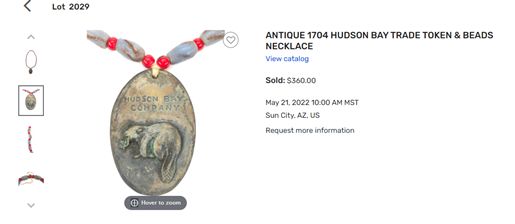Posted on: Tuesday October 31, 2023
The month of October is affectionately called ‘spooky season’ by many folks. While the word spooky makes most people think of ghosts, vampires, and other creepy things, equally spooky for me are the number of items for sale online marketed as authentic pieces of fur trade history!
Ok, maybe I’m trying too hard to connect this blog post to the season. BUT there is an abundance of fakes and forgeries on the market, all trying to entice unlikely buyers searching for Hudson’s Bay Company history. This trend is not seasonal, but it always make me cringe. I receive a few emails each year where someone has spent a substantial amount of money online on a bale seal, token, amulet, or trade axe and they want to learn more about it. I always feel so terrible when I have to let them know that they likely purchased a fake or forgery.
Which means it’s time for me to share some of my ‘red flags’ when looking at online auction sites for fur trade history. I’ve also written about two commonly forged items, bale seals and trade axes, for Canada’s History Magazine so you can read those too (links at the end of the blog!).
This month I decided to do a quick google search to see what came up when I typed “Hudson’s Bay Company tokens” and “Hudson’s Bay Company bale seals”. I immediately spotted numerous red flags: anytime I see a conjoined HB I’m a bit suspicious; iconography that bears no resemblance to the HBC Coat of Arms also sets off alarms; and anytime there’s a very old date stamped on the item my hackles raise. Why is that? Well, HBC was fairly routine with how, where, and when they marked their items. Although trade tokens were highly variable during the earlier years, and many posts made and issued their own, anytime HBC produced something it looked pretty official and often used their full name, or their coat of arms (or a portion of it).
Trade Tokens
Here are some examples of HBC trade tokens from the Museum Collection:

This is a set of the brass trade tokens for the East Main district. Note the Coat of Arms.

Here is a framed set of the thinner aluminum tokens used in the Arctic and the Labrador/St. Lawrence districts.
And here are some items I found this month, including this one from an auction house where somebody paid $360 USD in 2022 for an item that is clearly fake.

Note the large beaver icon in the centre and the miss-spelling of Hudson’s Bay Company.
And these tokens which are slightly better forgeries, but still fake none-the-less (and I am not a member of WorthPoint so I don’t know how much these sold for!).

These brass tokens look a little better but still not how HBC would mark their tokens.
This one on ebay might be the best forgery. It uses the Coat of Arms, but it’s still not a 1670 medallion. It looks modelled after a much later commemorative coin, and if you look at the reverse in the second image, there’s no way HBC was putting French on their early coins and tokens!

This is a pretty good looking fake, but the date, 1670, is the red flag. That’s not the Company’s name at that time period and it looks like a commemorative coin!

The reverse of this coin or token is also questionable, especially the French!
Bale Seals
Lead bale seals are another commonly faked item. I would encourage folks to look at images of actual bale seals to see that they’re relatively small, thin, and intended to be pinched or crimped. So there are often two parts with a small connecting piece. What I tend to see online are these thick, flat circles with crude HB or conjoined HB C on them and a perforated hole. Here are two similar examples both posted to a coin community forum:

The conjoined HB and chunkiness of these make me question their authenticity.

Again, this looks quite crude and unlike any authentic HBC bale seal.
And here are some examples from the HBC Collection. These are 20th century varieties, no longer made from lead but enamel-coated zinc or aluminum:

Zinc examples in the front, including one that has been pinched with red enamel-coated ones in the back, both featuring HBC coat of arms.

Three 20th century examples from the collection: plain zinc, red, and gold coloured.
So please be cautious when purchasing items online, because there’s nothing scarier than finding out you’ve wasted your hard-earned dollars!
Further Reading:



